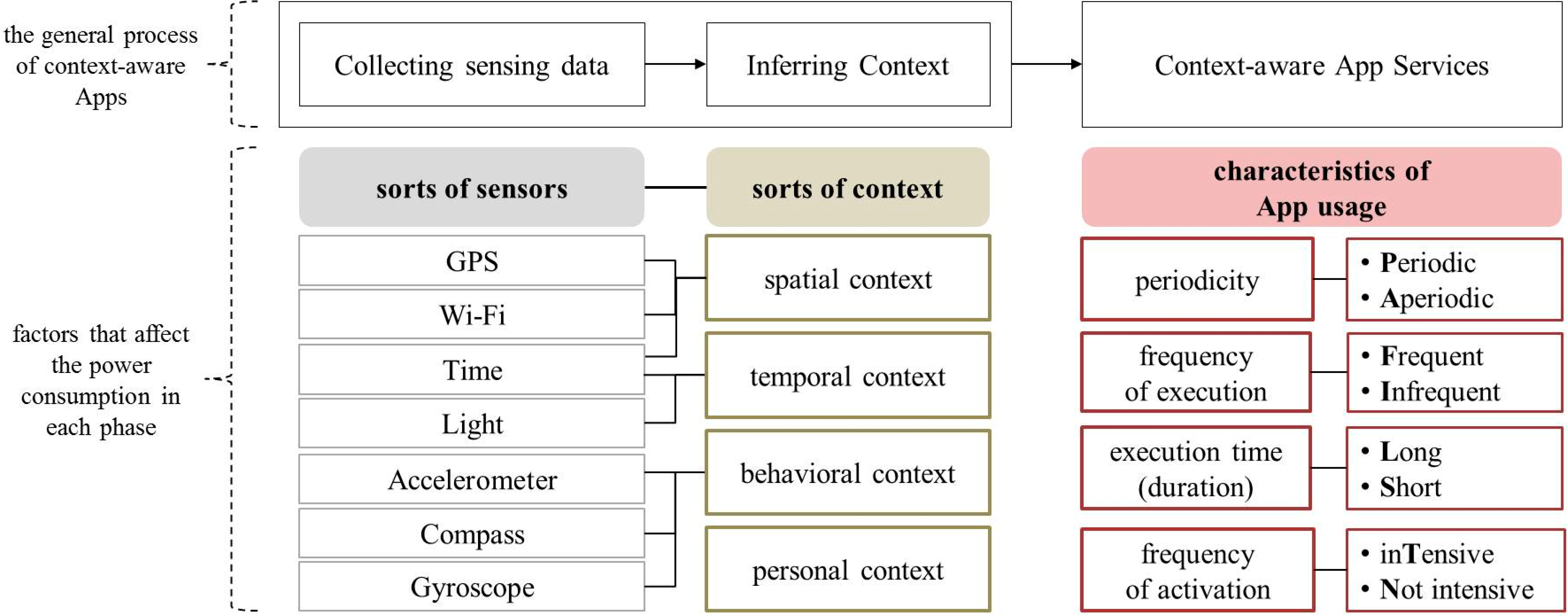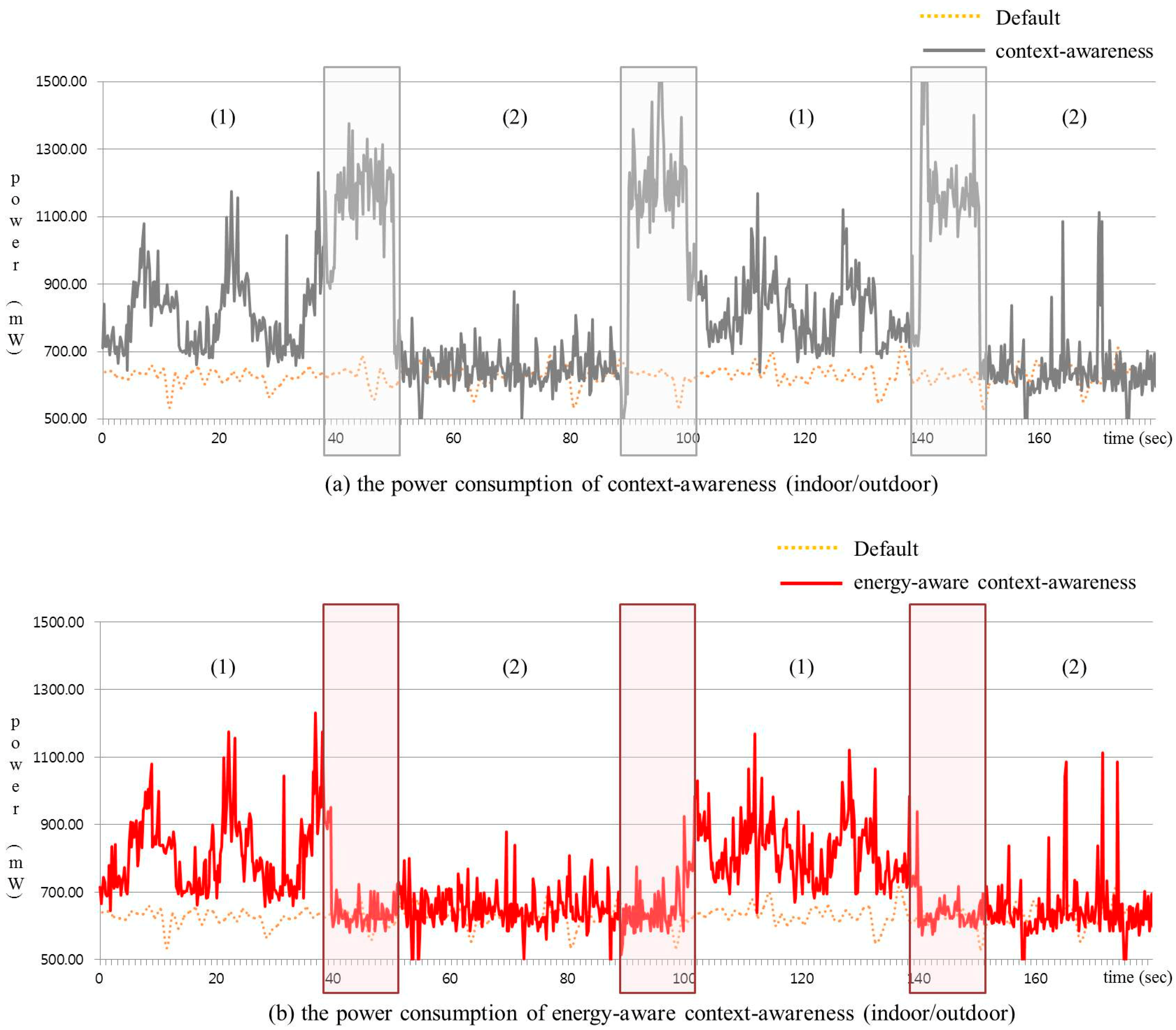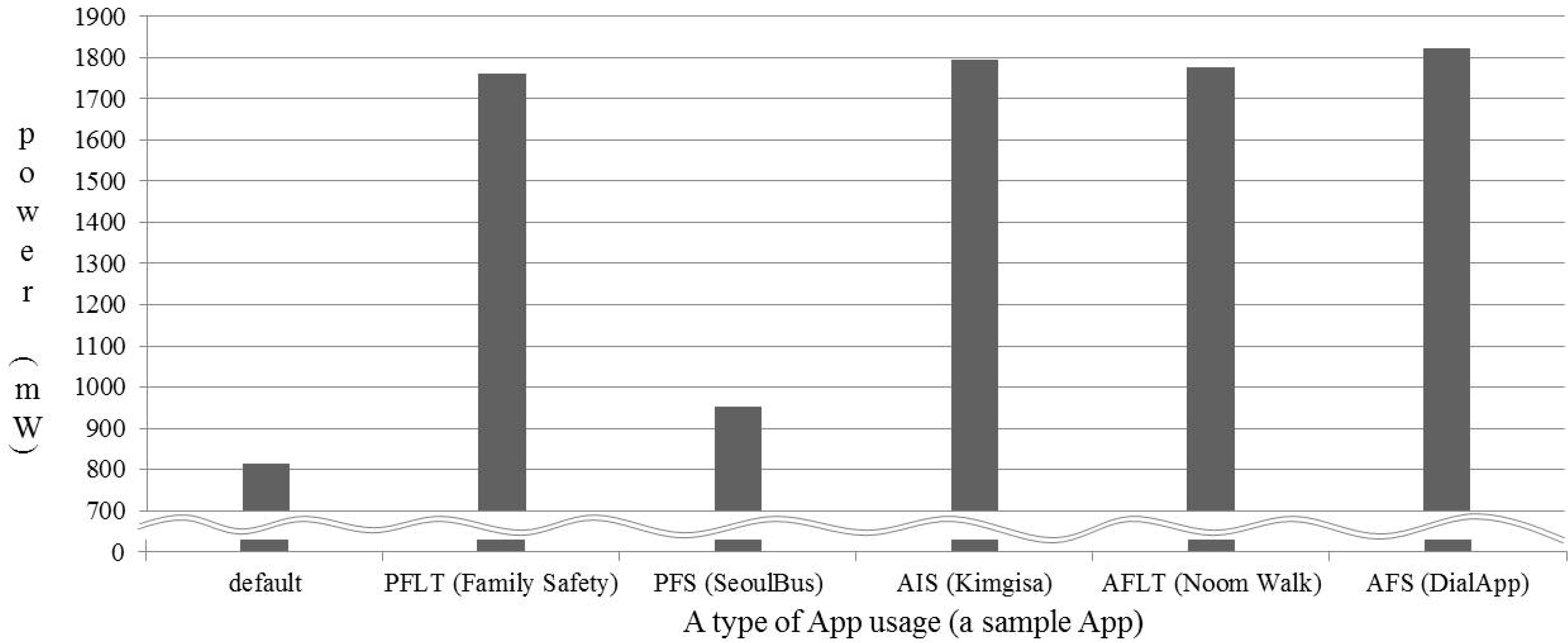Analysis of Characteristics of Power Consumption for Context-Aware Mobile Applications
Abstract
:1. Introduction
- (1)
- Context data acquisition: context-aware Apps collect low-level sensing data and simply pre-process them.
- (2)
- Context analysis: they infer the high-level context by modeling, training, analyzing and mining low-level data.
- (3)
- Service integration: they provide their own services according to the inferred real-time context.
2. Analysis of Characteristics of the Power Consumption

2.1. An App-Dependent Factor: Sorts of Context
| Type of context | Description (example) | Sensor |
|---|---|---|
| Spatial context | Location and location-related information of the mobile user (the latitude/longitude coordinates, the street address, the home, a friend’s place, etc.) | GPS, Wi-Fi, Time |
| Temporal context | Time and date information (time, date, season, etc.) | Time, Light |
| Behavioral context | Physical movements of the mobile user (walking, running, staying quietly, etc.) | Accelerometer, Compass, Gyroscope |
| Personal context | Data inputted by the mobile user (updated calendar events, the phone contact lists, etc.) | - |
2.2. A User-Dependent Factor: Types of App Usage
- Periodicity: this factor considers whether an App is executed with regular intervals. If a user executes an App regularly (with reasonable intervals, not exact), its periodicity is “Periodic”. And we defined that the usage of an App is “Aperiodic” when it is used irregularly.
- Frequency of execution: this factor considers whether an App is used frequently or infrequently. For example, if an App is used 10 times (>α) a day, then we can say that it is used in a “Frequent” way. In contrast, if a user runs an App just 2 times (≤α) a day, it is “Infrequent” usage.
- Execution time (duration): this factor is whether an App is executed for long time or short time. That is, this is about the temporal length of each execution of Apps. We classified characteristics of this property into two cases based on a certain threshold (time unit β), “Long” execution and “Short” execution.
- Frequency of activation: this factor means whether an App frequently runs sensors to collect and to generate context during its execution. After an App is executed, if it actuates related sensors many times (>γ) until it is completely stopped, its frequency of activation is “intensive”. Otherwise, the value of this property is “Not intensive”.
| Properties of the way of using Apps | Types | ||||
|---|---|---|---|---|---|
| Periodicity | Frequency of execution | Execution time (duration) | Frequency of activation | ||
| Periodic | Infrequent | Long | intensive | - | (a) |
| Not intensive | |||||
| Short | (both) | ||||
| Frequent | Long | intensive | PFLT | (b) | |
| Not intensive | PFLN | (c) | |||
| Short | (both) | PFS | (d) | ||
| Aperiodic | Infrequent | Long | intensive | AILT | (e) |
| Not intensive | AILN | (f) | |||
| Short | (both) | AIS | (g) | ||
| Frequent | Long | intensive | AFLT | (h) | |
| Not intensive | AFLN | (i) | |||
| Short | (both) | AFS | (j) | ||
- (a)
- Ignorable cases: we can ignore four cases (PILT, PILN, PIST, and PISN) due to an assumption that the usage of an App is frequent when it is executed with reasonable intervals. Therefore, we ignored the cases of “Periodic” and “Infrequent” usage.
- (b)
- PFLT: in the way of this type, an App is executed multiple times (>α) (F) with periodic intervals (P) for a day, and its each execution lasts for a long time (>β) (L), and it intensively collects and generates context during each execution (T).
- (c)
- PFLN: when a user uses an App in the way of this type, it is periodically (P) executed many times (>α) (F) and each execution has long duration (>β) (L), but context collection and generation by related sensors is occurred infrequently (N).
- (d)
- PFS: an App is periodically (P) and frequently (>α) executed (F), but each execution has short duration (≤β) (S). In this case, there is no significant influence of the number of activation because the execution time is short.
- (e)
- AILT: a user aperiodically (A) executes an App a few times (≤α) (I), but he/she uses it for a long time (>β) (L) and it activates sensors frequently (T).
- (f)
- AILN: an App is aperiodically (A) executed a few times (≤α) (I) during a long time (>β) (L) and it rarely collects/generates context (N).
- (g)
- AIS: an App is executed a few times (≤α) (I) with aperiodic intervals (A) for a day and it is stopped after a short time (≤β) (S). The influence of the frequency of activation on power consumption can be ignored, since the execution time is short.
- (h)
- AFLT: a user executes an App many times (>α) (F) aperiodically (A). The App is executed for long time (>β) (L) and often run sensors to get/generate context (T).
- (i)
- AFLN: an App is executed multiple times (>α) (F) with irregular intervals (A) for a day and each execution lasts for a long time (>β) (L), but context collection and generation is occurred less times (N).
- (j)
- AFS: in the way of this type, an App is executed multiple times (>α) (F) aperiodically (A) during a short time (≤β) (S). In this case, we can ignore the effect of the number of activation.
3. Experiment and Discussion


- A method to control the context generation: actually, the above first experiment is a pilot experiment for our idea. A possible low-power method can be to control the generation of context used by context-aware Apps. We can define context generation patterns or models of each “type of context”, and then control or limit the useless generation based on the model. For example, the first experiment applied a context generation control method to hold down the context generation in uncertain situations that indoor or outdoor, one of the “spatial context”, is unsure. This method can be expanded to other types of context.
- A method to control the frequency of activation: as another low-power method, context-aware Apps apply an algorithm for controlling their “frequency of activation”. According to our study in this paper, the frequency of activation of sensors is the most influential factor. Therefore, if an App is used in a way of “intensively frequent activation”, it can consider a method to effectively run sensors. For example, if the interval of activations is not reasonably long, it does not sense new sensing data and then can refer to the last one. Of course, this method should consider a type of context or characteristics of services provided by Apps.
4. Conclusions
Acknowledgments
Author Contributions
Conflicts of Interest
References
- Hoang, T.; Nguyen, T.; Luong, C.; Do, S.; Choi, D. Adaptive Cross-Device Gait Recognition Using a Mobile Accelerometer. J. Inf. Process. Syst. 2013, 9, 333–348. [Google Scholar] [CrossRef]
- Elgazzar, K.; Ejaz, A.; Hassanein, H.S. AppaaS: Provisioning of Context-aware Mobile Applications as a Service. In Proceedings of IEEE International Conference on Communications (ICC), Budapest, Hungary, 9–13 June 2013; pp. 2939–2943.
- Cho, H.; Choi, M. Personal Mobile Album/Diary Application Development. J. Converg. 2014, 5, 32–37. [Google Scholar]
- McNaull, J.; Augusto, J.C.; Mulvenna, M.; McCullagh, P. Flexible context aware interface for ambient assisted living. Hum. Centric Comput. Inf. Sci. 2014, 4. [Google Scholar] [CrossRef]
- Hong, S.; Chang, J. A New k-NN Query Processing Algorithm based on Multicasting-based Cell Expansion in Location-based Services. J. Converg. 2013, 4, 1–6. [Google Scholar]
- Howard, N.; Cambrai, E. Intention awareness: improving upon situation awareness in human-centric environments. Hum. Centric Comput. Inf. Sci. 2013, 3. [Google Scholar] [CrossRef]
- Augusto, J.C.; Callaghan, V.; Cook, D.; Kameas, A.; Satoh, I. “Intelligent Environments: A manifesto.”. Hum. Centric Comput. Inf. Sci. 2013, 32. [Google Scholar] [CrossRef]
- Oh, S. Using an Adaptive Search Tree to Predict User Location. J. Inf. Process. Syst. 2012, 8, 437–444. [Google Scholar] [CrossRef]
- Bisio, I.; Lavagetto, F.; Marchese, M. Context-Aware Smartphone Services. In Pervasive Computing and Communications Design and Deployment: Technologies, Trends and Applications, 1st ed.; Information Science Reference (IGI Global): Hershey, PA, USA, 2011; pp. 24–47. [Google Scholar]
- Korpipaa, P.; Mantyjarvi, J.; Kela, J.; Keranen, H.; Malm, E.-J. Managing Context Information in Mobile Devices. IEEE Pervasive Comput. 2003, 2, 42–51. [Google Scholar] [CrossRef]
- Chon, Y.; Cha, H. Lifemap: A Smartphone-based Context Provider for Location-based Services. IEEE Pervasive Comput. 2011, 10, 58–67. [Google Scholar] [CrossRef]
- Noh, H.Y.; Lee, J.H.; Oh, S.W.; Hwang, K.S.; Cho, S.B. Exploiting Indoor Location and Mobile Information for Context-awareness Service. Inf. Process. Manag. 2012, 48, 1–12. [Google Scholar] [CrossRef]
- Yurur, O.; Labrador, M.; Moreno, W. Adaptive and Energy Efficient Context Representation Framework in Mobile Sensing. IEEE Trans. Mobile Comput. 2013, 13, 1681–1693. [Google Scholar] [CrossRef]
- Aldhino, A.; Kim, Y.J.; Rim, K.W. A Survey of Low-power Techniques for Liquid Crystal Display Systems with Light Emitting Diode Backlight Units. IETE Tech. Rev. 2011, 28, 351–361. [Google Scholar] [CrossRef]
- Woo, S.; Seo, W.; Kim, C.; Huh, J. User Input based Power Reduction Technique for Smartphone. J. KIISE 2013, 40, 45–51. (In Korean) [Google Scholar]
- Liu, J.; Priyantha, B.; Hart, T.; Ramos, H.S.; Loureiro, A.A.F.; Wang, Q. Energy Efficient GPS Sensing with Cloud Offloading. In Proceedings of the 10th ACM Conference on Embedded Network Sensor Systems (SenSys’12), Toronto, ON, Canada, 6–9 November 2012; pp. 85–98.
- Bae, S-K. Power Consumption Analysis of Prominent Time Synchronization Protocols for Wireless Sensor Networks. J. Inf. Process. Syst. 2014, 10, 300–313. (In Korean) [Google Scholar]
- La, C.-A.; Varga, L.-O.; Heusse, M.; Duda, A. Energy-Efficient Multi-Hop Broadcasting in Low Power and Lossy Networks. In Proceedings of the 17th ACM International Conference on Modeling, Analysis and Simulation of Wireless and Mobile Systems (MSWiM’ 14), Montreal, QC, Canada, 21–26 September 2014; pp. 41–50.
- Khairy, A.; Ammar, H.H.; Bahgat, R. Smartphone Energizer: Extending Smartphone’s Battery Life with Smart Offloading. In Proceedings of the 9th International Wireless Communications and Mobile Computing Conference (IWCMC’13), Cagliari and Sardinia, Italy, 1–5 July 2013; pp. 329–336.
- Murmuria, R.; Medsger, J.; Stavrou, A.; Voas, J.M. Mobile Application and Device Power Usage Measurements. In Proceedings of the 6th IEEE International Conference on Software Security and Reliability (SERE’ 12), Gaithersburg, MD, USA, 20–22 June 2012; pp. 147–156.
- Wang, C.; Yan, F.; Guo, Y.; Chen, X. Power Estimation for Mobile Applications with Profile-Driven Battery Traces. In Proceedings of the 2013 International Symposium on Low Power Electronics and Design (ISLPED’ 13), Beijing, China, 4–6 September 2013; pp. 120–125.
- Zhan, K.; Lung, C.-H.; Srivastava, P. A Green Analysis of Mobile Cloud Computing Applications. In Proceedings of the 29th Annual ACM Symposium on Applied Computing (SAC’ 14), Gyeongju, Korea, 24–28 March 2014; pp. 357–362.
- Tu, Y. xTolk—a Context-aware Mobile Application on the Nokia N95 8GB Smartphone. Master’s Thesis, Technical University of Denmark, Denmark, 2008. [Google Scholar]
- Pathak, A.; Jindal, A.; Hu, Y.C.; Midkiff, S.P. What is Keeping My Phone Awake?: Characterizing and Detecting No-sleep Energy Bugs in Smartphone Apps. In Proceedings of the 10th International Conference on Mobile Systems, Applications, and Services (MobiSys’12), Low Wood Bay, UK, 25–29 June 2012; pp. 267–280.
- zoemob (Family Safety). Available online: https://www.zoemob.com/ (accessed on 15 August 2014).
- SeoulBus. Available online: http://seoulb.us/ (accessed on 15 August 2014).
- Kimgisa. Available online: http://cafe.naver.com/kimgisanavi (accessed on 15 August 2014).
- Noom (Noom Walk). Available online: http://www.noom.com/ (accessed on 15 August 2014).
© 2014 by the authors; licensee MDPI, Basel, Switzerland. This article is an open access article distributed under the terms and conditions of the Creative Commons Attribution license (http://creativecommons.org/licenses/by/4.0/).
Share and Cite
Lee, M.; Kim, D.-K.; Lee, J.-W. Analysis of Characteristics of Power Consumption for Context-Aware Mobile Applications. Information 2014, 5, 612-621. https://doi.org/10.3390/info5040612
Lee M, Kim D-K, Lee J-W. Analysis of Characteristics of Power Consumption for Context-Aware Mobile Applications. Information. 2014; 5(4):612-621. https://doi.org/10.3390/info5040612
Chicago/Turabian StyleLee, Meeyeon, Deok-Ki Kim, and Jung-Won Lee. 2014. "Analysis of Characteristics of Power Consumption for Context-Aware Mobile Applications" Information 5, no. 4: 612-621. https://doi.org/10.3390/info5040612
APA StyleLee, M., Kim, D.-K., & Lee, J.-W. (2014). Analysis of Characteristics of Power Consumption for Context-Aware Mobile Applications. Information, 5(4), 612-621. https://doi.org/10.3390/info5040612





